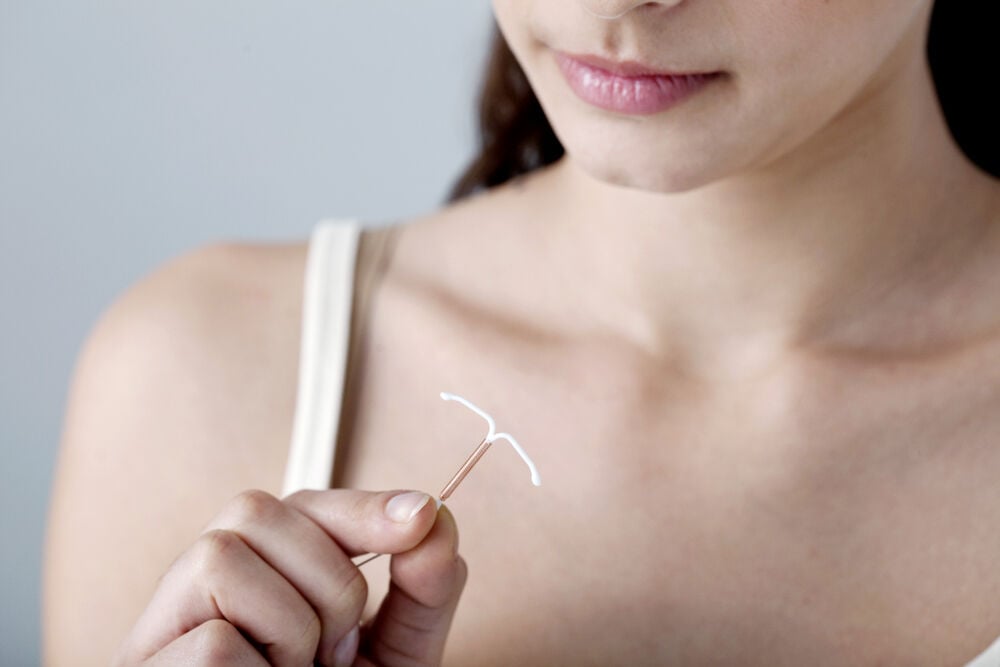If you’ve been curious about more long-term forms of birth control, you may have discovered IUDs as an option. There are two basic types of IUDs: hormonal ones and copper (non-hormonal) ones. Here’s everything you need to know about copper IUDs before you make your decision.
-
Tracking cycle
-
Getting pregnant
-
Pregnancy
-
Help Center
-
Flo for Partners
-
Anonymous Mode
-
Flo app reviews
-
Flo Premium New
-
Secret Chats New
-
Symptom Checker New
-
Your cycle
-
Health 360°
-
Getting pregnant
-
Pregnancy
-
Being a mom
-
LGBTQ+
-
Quizzes
-
Ovulation calculator
-
hCG calculator
-
Pregnancy test calculator
-
Menstrual cycle calculator
-
Period calculator
-
Implantation calculator
-
Pregnancy weeks to months calculator
-
Pregnancy due date calculator
-
IVF and FET due date calculator
-
Due date calculator by ultrasound
-
Medical Affairs
-
Science & Research
-
Pass It On Project New
-
Privacy Portal
-
Press Center
-
Flo Accuracy
-
Careers
-
Contact Us
Copper IUDs: Everything You Need to Know about Non-hormonal IUDs

Every piece of content at Flo Health adheres to the highest editorial standards for language, style, and medical accuracy. To learn what we do to deliver the best health and lifestyle insights to you, check out our content review principles.
What is a copper IUD?
A copper intrauterine device (IUD) is a type of non-hormonal birth control. There are also hormonal IUDs, but copper versions do not contain any hormones. This can be great for women who experience negative side effects from birth control that contains hormones. At the moment, ParaGard is the only copper IUD available in the United States.
How do copper IUDs work?
Copper IUDs have a T-shaped plastic frame with a very thin string at the end. A thin copper wire is coiled around the plastic parts of the device, which creates an inflammatory reaction in your uterus that is toxic to both sperm and eggs, preventing pregnancy.
What are the benefits of using a copper IUD?
The benefits of using a copper IUD are numerous for women. First and foremost, it’s a long-term form of birth control. Because there are no pills to remember or condoms to put on before sex, many women appreciate the freedom of using an IUD for birth control. There are many other benefits to using a copper IUD.
- It can remain in place for up to 10 years and can be removed at any time if you decide you want to become pregnant.
- It’s safe to use while breastfeeding following childbirth.
- It doesn’t carry the same risk of side effects that other hormonal forms of birth control do, including hormonal IUDs.
- If needed, the copper IUD can be used as emergency contraception if it’s inserted within five days of having unprotected sex.
Does a non-hormonal IUD have any side effects?

Take a quiz
Find out what you can do with our Health Assistant
While copper IUDs don’t have the same negative side effects as hormonal forms of birth control, there are a few side effects to be aware of. These side effects mostly arise when the non-hormonal IUD is first implanted.
Keep in mind that not every woman experiences the same side effects, because every woman’s body reacts differently. Potential side effects include:
- Pain in the abdomen or vagina when the IUD is inserted
- Mild to severe IUD cramping for a few days after it’s put in by your gynecologist
- Potential spotting between periods
- Irregular periods
- More painful cramps and heavier periods
In most cases, over-the-counter pain medicine can help with cramping or bloating. For the first two or three cycles after your copper IUD is inserted, your periods may be much heavier than usual. This usually tapers off after your uterus gets used to the IUD. Your periods may still be heavier than they were if you used hormonal birth control, but they shouldn’t be as heavy as you might experience during the first three months.
If the pain or bleeding doesn’t seem to get better or is very severe, you should call your gynecologist and let them know. Most clinics will also offer follow-up appointments about a month after the copper IUD is first inserted.
Please note that there are some contraindications to inserting copper IUDs that can be described by your doctor.
Is it painful to have a copper IUD inserted?
You may experience some pain or discomfort when you have your copper IUD put in. The process usually takes about 15 minutes or less. You may feel some painful pinches or significant pressure during the process. Most women are allowed to resume normal activities after IUD insertion, but some may choose to take it easy for a day or two. Keep lots of pain medication nearby to help with any cramping.
Women who have had children generally find the process less painful than women who haven’t had children.
What if you get pregnant with a copper IUD in?
Becoming pregnant with a copper IUD is extremely rare. It happens to less than 1 percent of women. If you do conceive with the copper IUD, it means you may be at high risk for an ectopic pregnancy, which is when the egg implants itself outside the uterus, usually in the fallopian tube. But because copper IUDs prevent most pregnancies, the chance of an ectopic pregnancy is much lower than it is for women who don’t use this birth control option.
What to expect after having a non-hormonal IUD inserted
Some women experience side effects for three to six months after getting their IUD inserted. Some of these side effects include pain before your period, heavier bleeding, and cramps. As mentioned before, over-the-counter pain medication can help you manage your discomfort.
For most women, these side effects don’t last forever. As your body gets used to the copper IUD, you are likely to notice fewer negative side effects.
How soon after removing a copper IUD can you get pregnant?
The amount of time it takes to get pregnant after stopping birth control may vary. When it comes to copper IUDs, women can try to conceive immediately after getting the IUD removed. Remember that every woman’s body is different. Some women can get pregnant right away after its removal, while others take longer.
How much does it cost to get a copper IUD?
The cost of getting a copper IUD inserted can vary depending on your health insurance. Some insurance companies cover the entire costs of copper IUDs, and others provide only partial coverage. If you’re not sure whether you’re covered, you can contact your insurance company, or your doctor may be able to do this for you.
That’s everything you need to know about copper IUDs. If you still have questions about different birth control options or copper IUDs in particular, your doctor can give you advice for your specific situation.


Hey, I'm Anique
I started using Flo app to track my period and ovulation because we wanted to have a baby.


The Flo app helped me learn about my body and spot ovulation signs during our conception journey.


I vividly
remember the day
that we switched
Flo into
Pregnancy Mode — it was
such a special
moment.
Real stories, real results
Learn how the Flo app became an amazing cheerleader for us on our conception journey.




